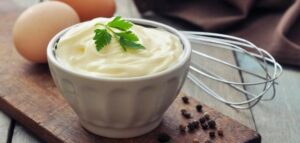Mayonnaise is a thick, emulsified food product prepared by whisking one or more vegetable oils prepared for food with vinegar and egg yolk in a watery medium,
NanoPro, we provide consultancy services for industrial food businesses that produce at different scales, We produce the most suitable solutions for your needs and support you in applying them to your projects. We have knowledge and experience in different fields in the food industry Some permitted additives may be used, Therefore, it is a semi-solid emulsion in which the oil is suspended in the aqueous medium by the egg yolk Vinegar and salt are the basic components of mayonnaise.

Table of Contents
The main ingredients of mayonnaise:
The main ingredients of mayonnaise:
1. Vegetable oil
Various types of vegetable oil can be used to make mayonnaise
2. Sugar
Sucrose (table sugar), corn syrup (fructose), glucose or any other sweetener can be used.
3. Salt
The table salt used must be pure.
4. Mustard
It is used in the form of mustard flour, which has important emulsifying properties, or in the form of mustard oil without affecting the emulsifying power.
5. Acidic substance
Date, apple, or grape vinegar is often used in the preparation of mayonnaise.
Egg yolk plays an important role in influencing the viscosity and emulsifying power of the product and can be used fresh, dried, or frozen. The egg yolk is the main source of the distinctive yellow color of mayonnaise.
7. Anti-crystallization
8. Antioxidants
9. Colourful materials
Colouring materials were also added during the production of mayonnaise with a different flavors:
10. Preservatives
11. Stabilizers
Many materials are used as stabilizers in the mayonnaise industry, and the usefulness of these materials is to stabilize the mayonnaise components
12. Flavoring agents
There is a feast of chemical compounds used as exhausting materials used in the manufacture of mayonnaise
13. glucose oxidase enzymes
There are specific enzymes that are used as glucose oxidizers
Types of mixes
Types of mixes,There are certain types and mixtures of mayonnaise, for example
First, the basic mixture.
Second / the alternative mixture (the mixture according to European specifications)
Third, the commercial alternative mixture
Fourth / egg-free mixture
production line: –
———–
The mayonnaise production line for industrial factories operates on the Botch system, which consists in the form of stages with three tanks. These tanks are equipped with mixers whose speed can be controlled, and they are connected from the bottom with a pump to regulate the flow of the product mixture to the Colloid Mill mixer, in which the emulsification is completed, and from it the finished product is pumped to the filling and closing device.
Manufacturing steps:
—————–
1- The industrial mayonnaise manufacturing steps are in the form of a first stage, which includes mixing the dry ingredients, and the second stage includes adding the liquid ingredients to the initial mixture.
2- After completing the previous step, the product descends to the bottom of the mixer nozzle, where the pump and the colloidal mixer are stopped and the valve is closed, so that the product can be pumped to the filling devices.
3- Packaging: – The product is packed in glass containers, and air is drawn on them from the vertical space, then the process of closing tightly to prevent air from reaching the product.
4- Storage: – Storage is carried out at temperatures of 5°C.
Characteristics of good mayonnaise
1- The final product should have good color of white to yellowish, which indicates the quality of the product
The zero color comes from the carotene in eggs (.
2- The product should be in the form of a semi-solid emulsion that does not spill when turning the can.
3- The product should be homogeneous, smooth, and free of lumps.
4- It should be of stable consistency and not show signs of separation when placed in an oven at a temperature of 38 ° C for 48 hours.
5- It has a good flavor and taste and is free from rancidity and rotting effects.
6- Free from foreign matter, seeds and insects.
7- The proportions of the final product should be as shown below:
a. The percentage of linoleic acid should not exceed 5.0% of the weight of the product, provided that the oil is tested after separating it from the product.
b. The percentage of oil should not be less than 75%
c. The egg yolk should not be less than 7% as a soft product.
d. Acidity 5.2% acetic acid
8- The stabilizers should be of materials suitable for human consumption and allow for healthy use (starch, salt, sugar, and antioxidants).
9- Adding preservatives such as benzoic acid or sorbic acid salts not exceeding 1.0% calculated on the basis of benzoic acid and sorbic acid.
10- That the total count of bacteria does not exceed 5000/gm.
11- The number of colon bacteria should not exceed 10 / g.
12- The number of yeasts and molds should not exceed 20/gm
13- The percentage of contamination with metal pollutants should not exceed 2.0 parts per million, copper per million, and lead 1.0 parts per million.
———————-
Problems that accompany food laboratories when manufacturing
1- The appearance of the mold a few days after the manufacture of mayonnaise containers. This phenomenon is not useful for food laboratories because it causes product spoilage and reduces the storage period.
2- Separation the oil from the rest of the ingredients in the mayonnaise product
With all these problems, NanoPro, with its long experience, can provide consultations in food manufacturing to avoid these problems and follow up the manufacturing lines from the beginning until obtaining a product of good strength and with a long period of storage, based on the standard specifications of each country.

1 Comment
her u are